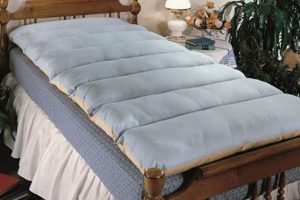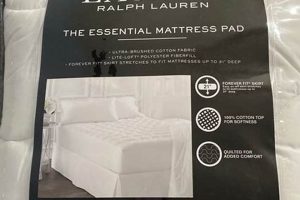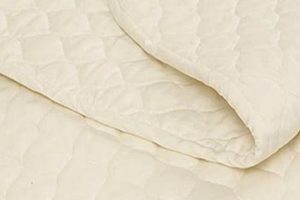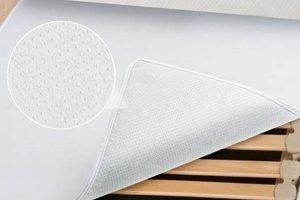This bedding accessory serves as an additional layer of cushioning placed atop a mattress. It typically consists of a fabric encasement filled with materials such as down, feathers, fiberfill, memory foam, or latex. The purpose is to enhance comfort and provide an extra level of support beyond the mattress itself, creating a softer sleeping surface. For example, a firm innerspring mattress might be paired with this item to alleviate pressure points and improve overall sleep quality.
The importance of this bedding enhancement lies in its ability to personalize the sleep experience. By adding a layer of plushness, it can significantly improve comfort, particularly for individuals with joint pain, pressure sensitivity, or those who simply prefer a softer bed. Historically, the concept of adding extra layers to sleeping surfaces dates back centuries, with simpler versions utilized to protect mattresses and provide warmth. Modern iterations offer a wide range of materials and construction techniques, allowing consumers to tailor their bed to specific needs and preferences.
Understanding the construction, materials, and maintenance of these bedding components is crucial for making an informed purchase. The following sections will explore various aspects, including the types of fill materials, cleaning and care guidelines, and factors to consider when selecting the appropriate size and thickness to complement an existing mattress.
Optimal Use Strategies
The following guidelines will assist in maximizing the lifespan and comfort provided by this sleep surface enhancement.
Tip 1: Select Appropriate Density: Consider body weight and preferred sleeping position when selecting density. Lighter individuals or side sleepers may benefit from a lower-density fill, while heavier individuals or back sleepers might require a higher-density option for adequate support.
Tip 2: Regularly Rotate: Consistent rotation can help to evenly distribute wear and prevent indentations. Rotate the item end-to-end every one to three months, depending on usage.
Tip 3: Utilize a Mattress Protector: Employing a mattress protector over the entire bed, including this component, safeguards against spills, stains, and allergens, thereby extending its usable life.
Tip 4: Adhere to Cleaning Instructions: Carefully follow the manufacturers cleaning instructions. Some models may be machine washable, while others require spot cleaning or professional cleaning services.
Tip 5: Consider Allergen Sensitivity: Individuals with allergies should opt for hypoallergenic fill materials, such as latex or specific types of synthetic fibers, to minimize allergic reactions.
Tip 6: Evaluate Mattress Compatibility: The effectiveness of this bedding addition is dependent on the underlying mattress. A worn or unsupportive mattress will diminish the overall comfort and support, regardless of the quality of the additional layer.
Consistent implementation of these strategies will contribute to improved comfort, extended product lifespan, and a more hygienic sleep environment.
The concluding section will provide a summary of key considerations and insights for making an informed purchase.
1. Comfort
The primary function of a bed pillow top mattress pad is to enhance comfort during sleep. This added layer atop the mattress directly influences the tactile experience, modifying the firmness and contouring properties of the sleep surface. Materials used in construction determine the degree of plushness or support offered. For example, a pad filled with down or feathers will provide a softer, more yielding feel compared to one filled with high-density memory foam, which offers firmer support and pressure relief. The immediate effect is a reduction in pressure points, particularly at the shoulders, hips, and knees, potentially mitigating discomfort for individuals with joint pain or pressure sensitivity.
The level of comfort derived from this bedding element is not solely dependent on the materials. Its interaction with the underlying mattress is crucial. A pad can soften an overly firm mattress, providing immediate relief. Conversely, it cannot compensate for a mattress that lacks adequate support or is significantly worn. Choosing a pad that complements the existing mattress characteristics is vital. Consider, for instance, a side sleeper experiencing shoulder pain on a firm mattress. Adding a plush pad can alleviate pressure and improve sleep quality. However, if the mattress itself is sagging, the pad’s effectiveness will be limited, and a mattress replacement may be necessary.
Ultimately, the perceived comfort is subjective and varies based on individual preferences and physical needs. While a pillow top pad can significantly enhance the sleep experience, it is essential to carefully evaluate material properties, thickness, and compatibility with the existing mattress to achieve optimal results. Disregarding these factors may lead to dissatisfaction and negate the intended benefits. Therefore, understanding the interplay between the pad and the underlying mattress is paramount for achieving desired levels of comfort and support.
2. Support
The level of support provided by a bed pillow top mattress pad is a critical factor influencing sleep quality and musculoskeletal health. While often perceived primarily as a comfort enhancer, the capacity of these pads to contribute to proper spinal alignment and pressure distribution is significant.
- Spinal Alignment
A supportive pad can help maintain the natural curvature of the spine during sleep, preventing or alleviating back pain. For instance, a memory foam pad contours to the body, providing targeted support to the lumbar region. In contrast, an overly soft or unsupportive pad may allow the spine to sag, exacerbating existing back problems or creating new ones.
- Pressure Distribution
Effective support minimizes pressure points that can lead to discomfort and restless sleep. A pad that evenly distributes weight across the sleep surface reduces stress on specific areas, such as the hips and shoulders. An example is a latex pad, which offers both cushioning and resilient support, preventing pressure buildup.
- Edge Support
The edge support of a bed pillow top mattress pad impacts usability of the entire sleep surface. Without adequate edge support, individuals may experience a “roll-off” sensation near the perimeter of the bed, limiting usable space and potentially compromising sleep posture. A pad with reinforced edges can mitigate this issue, providing a more stable and secure sleep environment.
- Material Density and Construction
The density and construction techniques used in manufacturing directly affect its support properties. High-density materials, such as certain types of memory foa
m or latex, generally offer more robust support than low-density alternatives. Moreover, quilted construction or zoned support systems can enhance targeted support to specific areas of the body.
The supportive qualities of a bed pillow top mattress pad are integral to its overall performance. By promoting proper spinal alignment, distributing pressure evenly, and providing adequate edge support, these pads contribute to a more restful and healthful sleep experience. Selecting a pad with appropriate material density and construction is essential to maximizing these benefits.
3. Materials
The selection of materials constitutes a fundamental determinant of a bed pillow top mattress pad’s performance characteristics, including comfort, support, durability, and thermal regulation. Material composition directly impacts the tactile experience, influencing the degree of plushness, firmness, and contouring provided. For instance, a mattress pad filled with natural down provides a soft and luxurious feel, while a pad constructed from high-density memory foam offers firmer support and enhanced pressure relief. The choice of material, therefore, has a direct cause-and-effect relationship with the overall sleep experience.
The importance of material selection extends beyond immediate comfort considerations. The materials used significantly affect the pad’s ability to regulate temperature and manage moisture. Natural fibers like cotton and wool exhibit breathability and moisture-wicking properties, promoting a cooler and drier sleep environment. Conversely, synthetic materials such as polyester may retain heat, potentially leading to discomfort for individuals prone to night sweats. Material also affects the overall durability and lifespan of the product. High-quality materials, such as latex or tightly woven fabrics, withstand wear and tear better than cheaper alternatives. For example, a pad with a durable cover and resilient fill material maintains its shape and support over time, whereas a pad made with low-quality materials may quickly flatten and lose its effectiveness.
In conclusion, the practical significance of understanding the materials used in a bed pillow top mattress pad is undeniable. Informed material selection enables consumers to prioritize their specific needs and preferences, whether it be enhanced comfort, superior support, improved thermal regulation, or prolonged durability. Neglecting material considerations may lead to dissatisfaction and premature product failure. The interplay between material composition and overall performance underscores the critical importance of making informed choices when selecting these sleep surface accessories.
4. Thickness
The thickness of a bed pillow top mattress pad directly influences its capacity to alter the firmness and support characteristics of the underlying mattress. A thicker pad generally provides a greater degree of cushioning and pressure relief. For instance, a pad measuring three inches in thickness will typically offer more significant impact on the overall sleep surface feel than a pad measuring one inch. The practical consequence of this difference lies in the degree to which the pad can mitigate pressure points and enhance comfort. Consider an individual experiencing discomfort on a firm mattress; a thicker pad can effectively soften the surface, alleviating pressure on areas such as the hips and shoulders.
Variations in pad thickness also affect their suitability for different mattress types. A thinner pad may be sufficient for a mattress that already provides adequate support but requires a slight enhancement in comfort. Conversely, a thicker pad can be advantageous when attempting to compensate for an aging or overly firm mattress. The chosen thickness level must also take into account any fitted sheets, as an excessively thick pad may strain the elastic or prevent proper fit. For example, using a standard-sized fitted sheet on a mattress with an extra-thick pad can result in the sheet constantly slipping off. Additionally, thicker pads may require deeper-pocketed sheets specifically designed to accommodate the added height.
In summary, pad thickness is a critical factor to consider when selecting a bed pillow top mattress pad. Its influence extends to comfort, support, and the overall compatibility with existing bedding. Understanding the cause-and-effect relationship between thickness and performance allows for a more informed purchase decision, ensuring that the chosen pad effectively addresses individual sleep needs and preferences.
5. Maintenance
The longevity and hygienic state of a bed pillow top mattress pad are directly contingent upon consistent and appropriate maintenance. Regular care, encompassing cleaning and protection measures, mitigates the accumulation of allergens, dust mites, and bodily fluids, thereby prolonging the pad’s lifespan and preserving its intended comfort and support characteristics. Neglecting maintenance protocols leads to degradation of the fill material, compression of the padding, and potential development of unpleasant odors. For example, consistent exposure to perspiration without periodic cleaning can cause the fill to clump and lose its resilience, diminishing its ability to provide even support.
Specific maintenance requirements vary based on the materials used in the construction of the mattress pad. Certain fills, such as down or feathers, necessitate professional cleaning to avoid damage and ensure proper loft restoration. Other materials, including memory foam or synthetic fibers, may be suitable for machine washing, provided that manufacturer instructions are strictly adhered to. The use of a mattress protector is a crucial preventative measure, creating a barrier against spills, stains, and allergens, thereby reducing the frequency and intensity of required cleaning. For example, a waterproof mattress protector can prevent accidental spills from penetrating the pad, minimizing the risk of mold or mildew growth. Routine vacuuming further helps to remove surface dust and debris.
In summation, diligent maintenance is an integral component of bed pillow top mattress pad ownership. Adherence to proper cleaning techniques, coupled with preventative measures such as mattress protectors, is vital for optimizing the pad’s lifespan, preserving its comfort and support properties, and maintaining a hygienic sleep environment. Failure to prioritize maintenance not only diminishes the product’s value but also compromises sleep quality and potentially poses health risks. Therefore, understanding and implementing appropriate maintenance protocols is paramount for realizing the full benefits of this bedding accessory.
6. Lifespan
The lifespan of a bed pillow top mattress pad represents a critical economic and functional consideration for consumers. The durability and longevity of these accessories directly impact their cost-effectiveness and sustained ability to enhance sleep quality.
- Material Composition and Degradation
The inherent properties of the materials used in constructio
n dictate the rate of degradation. Natural materials like down or latex may exhibit different wear patterns compared to synthetic fills such as memory foam or polyester fiber. For example, down clusters can break down over time, losing their loft and insulating properties, whereas memory foam may develop impressions and lose its original shape. Understanding these material-specific degradation processes informs purchasing decisions and maintenance practices. - Usage Intensity and Wear Patterns
The frequency and intensity of use significantly contribute to wear and tear. Individuals who sleep on the same spot consistently may experience localized compression of the fill material, leading to uneven support and reduced comfort. Rotating or flipping the mattress pad, if feasible, can help distribute wear more evenly and extend its lifespan. Consider the scenario of a single sleeper versus a couple; the latter will generally exert greater pressure and wear on the pad, potentially shortening its lifespan.
- Maintenance Practices and Their Impact
Adherence to proper cleaning and care guidelines directly influences the longevity of the bedding accessory. Regular washing or professional cleaning, as recommended by the manufacturer, removes accumulated dirt, allergens, and bodily fluids that can degrade the fill material. Failure to maintain the pad properly accelerates deterioration and diminishes its intended performance. For instance, neglecting to protect the pad with a mattress protector can expose it to stains and moisture, leading to premature breakdown of the materials.
- Construction Quality and Durability
The manufacturing techniques employed in creating the mattress pad contribute to its structural integrity and resistance to wear. Reinforced seams, baffle box construction (in the case of down or feather fills), and high-quality cover fabrics enhance durability and prevent premature failure. Lower quality construction may result in tearing, shifting of fill material, and a reduced overall lifespan. Compare a pad with tightly stitched seams to one with loose stitching; the former is likely to withstand more stress and last longer.
These factors collectively determine the economic value and practical lifespan of a bed pillow top mattress pad. A well-constructed and properly maintained pad, utilizing durable materials, represents a sound investment by providing sustained comfort and support over an extended period. Conversely, neglecting these considerations may lead to premature replacement and diminished value.
Frequently Asked Questions
The following addresses common inquiries regarding bed pillow top mattress pads, providing clarity on their functionality, benefits, and proper usage.
Question 1: Does a bed pillow top mattress pad negate the need for a new mattress?
A bed pillow top mattress pad serves as a supplemental layer to enhance comfort and support but does not replace a worn or unsupportive mattress. While it can temporarily improve the feel of a mattress, it cannot address underlying structural issues or compensate for a lack of proper support.
Question 2: What are the primary advantages of using a bed pillow top mattress pad?
The primary advantages include enhanced comfort through added cushioning, improved pressure relief by distributing weight more evenly, and potential mitigation of discomfort for individuals with joint pain or pressure sensitivity. Furthermore, it can extend the lifespan of the underlying mattress by protecting it from wear and tear.
Question 3: How does one determine the appropriate thickness for a bed pillow top mattress pad?
The appropriate thickness depends on individual preferences and the characteristics of the existing mattress. A thicker pad typically provides more significant cushioning and is suitable for firmer mattresses. Thinner pads are appropriate for mattresses that offer adequate support but require a slight increase in comfort.
Question 4: What materials are commonly used in bed pillow top mattress pads, and what are their respective benefits?
Common materials include down, feathers, memory foam, latex, and synthetic fibers. Down and feathers offer a soft and luxurious feel. Memory foam provides conforming support and pressure relief. Latex offers a balance of comfort and support, while synthetic fibers are often hypoallergenic and more affordable.
Question 5: How should a bed pillow top mattress pad be cleaned and maintained?
Cleaning and maintenance protocols vary depending on the fill material. Some pads may be machine washable, while others require spot cleaning or professional cleaning. Utilizing a mattress protector is highly recommended to prevent stains and allergens. Regular vacuuming helps to remove surface dust and debris.
Question 6: How long does a bed pillow top mattress pad typically last?
The lifespan of a bed pillow top mattress pad depends on the quality of materials, usage intensity, and maintenance practices. High-quality pads, properly maintained, can last for several years. Regular rotation, cleaning, and the use of a mattress protector contribute to extended longevity.
These FAQs provide a foundational understanding of bed pillow top mattress pads. Informed purchasing decisions and consistent maintenance contribute to optimal sleep quality and product longevity.
The subsequent section will delve into the practical application of selecting and utilizing this bedding accessory.
Conclusion
The preceding analysis has explored various facets of the bed pillow top mattress pad, emphasizing its role in enhancing sleep comfort and support. The critical considerations, including material composition, thickness, maintenance requirements, and lifespan determinants, underscore the importance of informed decision-making. Properly selected and maintained, the item can significantly improve sleep quality and extend the lifespan of an existing mattress.
Understanding the nuances of this bedding accessory enables consumers to make strategic choices aligned with individual needs and preferences. Continued research and innovation in material science and design will likely yield further advancements in bed pillow top mattress pad technology, offering even greater potential for optimizing sleep environments. The future of sleep comfort hinges on a commitment to informed consumerism and ongoing exploration of novel bedding solutions.





![Find Your Best Pillow Top Mattress Pad [Guide + Reviews] Organic & Natural Mattress Buyer’s Guide: Non-Toxic Sleep Solutions Find Your Best Pillow Top Mattress Pad [Guide + Reviews] | Organic & Natural Mattress Buyer’s Guide: Non-Toxic Sleep Solutions](https://mattressworldpa.com/wp-content/uploads/2025/07/th-4675-300x200.jpg)
![Top RV Queen Mattress Pad [Comfort Boost] Organic & Natural Mattress Buyer’s Guide: Non-Toxic Sleep Solutions Top RV Queen Mattress Pad [Comfort Boost] | Organic & Natural Mattress Buyer’s Guide: Non-Toxic Sleep Solutions](https://mattressworldpa.com/wp-content/uploads/2025/07/th-4674-300x200.jpg)
